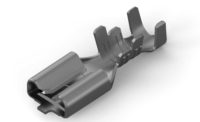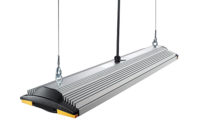More Efficient Motors
HVAC industry looks to more efficient BPM motors to comply with new efficiency regulations.

This is a full communicating constant CFM furnace ECM. Source: Nidec
Original equipment manufacturers in the heating, ventilation and air conditioning industry have an opportunity to help both their customers and themselves as they prepare to comply with new energy conservation standards for residential furnace fans.
Beginning July 3, 2019, the U.S. Department of Energy’s new standards that regulate the minimum efficiency of gas-fired furnace fans take effect. Few, if any, legacy systems that utilize permanent split capacitor (PSC) motors will meet this new Fan Energy Rating (FER), which is based on the airflow provided by the furnace fan.
The FER considers the electricity consumed as these fans circulate air heated by a furnace through a home’s duct system into living spaces, as well as cooled air circulated in air-conditioned homes. Today’s average residential furnace fan consumes about 1,000 kWh of electricity a year, according to the DOE. That accounts for nearly 10% of an average household’s electricity use—making the furnace fan one the largest users of electricity in a typical home.
Furnace fans that comply with the new DOE regulations should make it possible for average energy use to drop by about 40% to approximately 600 kWh annually. Furnace OEMs have several levers they can pull to get there and their engineering teams are evaluating every conceivable option to satisfy this new requirement at the best possible cost. It appears that in almost every case furnace OEMs are focusing their efforts on the single greatest consumer of electricity in their furnaces: fan motors.

DOE FER Regulations will push motor demand to constant torque ECM. Source: Nidec
Transitioning from PSC to BPM motors
Most fans today in gas-fired furnaces contain PSC motors. These motors operate at 60% to 65% peak efficiency.
Furnace fan efficiency can be significantly improved by switching to brushless permanent magnet (BPM) motors, which operate at approximately 82% peak efficiency.
While BPM motors provide a simple path to FER compliance, less than half of furnaces in the market are currently using BPM technology. That’s because there are a few stumbling blocks along the way.
The major one is cost. The fan motor is one of the most expensive components of a furnace, and an off-the-shelf BPM motor can cost as much as three times that of the PSC motor it will replace. That is a significant cost to pass onto residential customers. Furnace OEM and motor manufacturers’ challenge is to find ways to minimize this cost as much as possible.
The good news is, by working together, the two industries are optimizing furnace performance for the upcoming DOE regulations. Furnace OEMs have been diligently working towards the best motor and fan combination to meet the new performance standards.
To see how, it’s important to first understand the fundamental differences between PSC and BPM motors.
A PSC motor is an induction motor that is driven by line voltage. It is designed to do two basic things: to turn on and to turn off. The motor speed is determined by the system design and installation static pressure; electrical output can’t be controlled.
When looking at a PSC efficiency curve, peak efficiency is achieved at a single speed, and drops off quickly as you move away from this optimal condition. In comparison, a BPM efficiency curve is higher and considerably flatter over a broad operating range. The difference in efficiency curves illustrates the BPM motor’s greater operating efficiency over at larger range versus the PSC. This operating range includes circulation speed, which is a low efficient operating point for PSC motors, and the largest improvement with the switch to BPM technology.

To design a PSC motor for a furnace fan, in other words, a furnace OEM would need to define to the motor manufacturer the precise speed and power at which it wanted the motor to operate. The motor manufacturer would then design a motor to those specifications and send a sample to the furnace OEM for testing. If the motor’s operation needed to be tweaked, the OEM would identify new specifications, and the manufacturer would create a new sample. It could take several back-and-forths to achieve the desired results and may even require a modification to the blower wheel to accommodate the needs of the PSC motor.
With BPMs, furnace OEMs no longer need to go through the process of multiple iterations of PSC samples to achieve desired performance because BPM motors are not only more energy efficient. Because they are driven by electronics, with the assistance of development hardware and software, changes in motor performance can be made in real time, resulting in significant reduction in motor development time.
Unlike PSC motors, BPM motors have electronic speed and torque controls built in. They are electronically controlled to ensure optimal airflow for given conditions. The controls are designed to convert single-phase energy to three-phase power, and by modifying the waveforms input to the motor, it is possible to achieve approximately 20 percentage points more efficiency than single-phase PSC motors, even at peak conditions.
Because these motors are driven by electronics, it is also possible to program their speed and torque through the electronic controller incorporated into the motor. That is good news to OEM product developers, who can simply define the desired torque and speed settings they want in a motor. The electronic controller is plugged into a computer, which “communicates” to the electronic drive and programs those settings into the motor automatically. If a speed or torque change is needed, the motor can simply be reprogrammed.
Because BPM motors have the same size diameter as a standard furnace PSC motors, they can also be incorporated into most furnace fans without additional design changes to the OEM’s furnace.
Seen another way, the new FER regulation offers a perhaps unexpected benefit to OEMs. By encouraging the use of BPM motors, the regulation also helps shorten the time needed to bring new furnace products to market. Because of the ease of programming BPM motors and tweaking their performance, motor selection will no longer be a bottleneck in new product development.
Value to the distributors, after-market and consumers
While OEMs are most immediately impacted by the new FER regulations, distributors, HVAC contractors and other after-market companies should find that their own operational efficiency will improve with the switch to BPM motors.
The four primary BPM furnace motor ratings—1/3, 1/2, 3/4 and 1 hp motors—can be shipped to distributors preprogrammed. Moreover, for greater customization the distributors are provided with tools that allow the preprogramed BPM motor to be reprogramed to match the performance of the original motor in the homeowner’s system. That greatly simplifies their stocking requirements.
Residential HVAC contractors may have even more to gain. Currently, if these contractors go out into the field on a service call and discover a failed heating fan motor, they often must return to the distributor for replacement motors. The wide range of PSC motor options now in use make it difficult to carry the correct replacement motors on a service van or truck.
The transition to BPM motors should change that equation. Instead of carrying dozens of motors, an HVAC service company can instead stock just four different models on their trucks. The industry is now moving in the direction of making it possible for these contractors to program the BPM motors themselves.
We now provides contractors with a phone app they can use to program a motor in the field. As an example, if a contractor arrives at a home with a failed ½ hp motor, the technician simply reads the failed motor’s nameplate to obtain the motor’s part number. They then plug the programming tool into a ½ hp new motor and connect it to an app on their phone. A few finger taps later, the new motor has been programmed with the correct settings.
The flexibility of the BPM motors is expected to save contractors the considerable time and expense of making a return trip to pick up the correct model. Homeowners should appreciate the faster repair turnaround as well.
While initial costs will likely be higher for consumers, the new motors will pay for themselves, and more, over time. Because the furnace fan is responsible for approximately 10% of a typical homeowner’s electric consumption, a more efficient BPM fan motor should make a noticeable financial impact versus furnaces with PSC motors. In addition to the individual impact, from a macro level it will also produce fewer carbon emissions (DOE estimates a reduction of 180 million metric tons of CO2) and place less demand on the power grid.
What’s Next? Collaborative Effort by Furnace OEMs & Motor Manufacturers is Key
BPM motors that are available in the market today can help furnace OEMs meet FER performance targets. That is the good news. But it’s not good enough To mitigate the cost impact to the end-customer by making the switch from PSC to BPM motors, and create a better value product, OEMs and motor manufacturers need to partner in open collaboration for even better solutions.
Some motor manufacturers, for example, are already working to optimize BPM design for furnace fans. The realization has been that a standard 82% efficient BPM motor may be overkill to meet the new regulations. Instead of offering a single level of efficiency but rather, multiple efficiency tiers, the furnace OEMs can meet both performance and cost targets inherent in the FER furnace redesign process.
It’s clear that the BPM motor is the driving motor technology once the FER regulations are fully implemented. However, further innovation is prudent to create the best value for the market. Furnace OEMs who collaborate with motor companies, as well as blower wheel and blower housing manufacturers on these efforts will have more success in developing finished products that both meet regulatory efficiency standards AND the customer pricing demands.
Today’s B PM solution is a start, but by working together, the two industries can do even better.
Looking for a reprint of this article?
From high-res PDFs to custom plaques, order your copy today!





